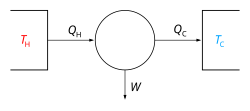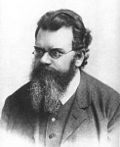In quantum mechanics, indistinguishable particles (also called identical or indiscernible particles) are particles that cannot be distinguished from one...
33 KB (5,500 words) - 20:42, 19 June 2025
Spin–statistics theorem (category Particle statistics)
particles: any physical prediction relating multiple indistinguishable particles must not change when the particles are exchanged. [citation needed] In a quantum...
25 KB (3,192 words) - 17:51, 25 June 2025
states space of a variable or unknown number of identical particles from a single particle Hilbert space H. It is named after V. A. Fock who first introduced...
16 KB (2,904 words) - 17:40, 19 April 2025
Look up indistinguishability in Wiktionary, the free dictionary. Indistinguishability may refer to: Identical (indistinguishable) particles Computational...
422 bytes (58 words) - 21:47, 8 May 2024
non-interacting, identical particles that obey the Pauli exclusion principle. A result is the Fermi–Dirac distribution of particles over energy states. It...
30 KB (4,826 words) - 12:23, 11 July 2025
example, a system with two indistinguishable particles, with particle 1 in state ψ 1 {\displaystyle \psi _{1}} and particle 2 in state ψ 2 {\displaystyle...
44 KB (5,318 words) - 10:01, 30 June 2025
material particles over various energy states in thermal equilibrium. It is applicable when the temperature is high enough or the particle density is...
27 KB (5,296 words) - 20:44, 5 June 2025
when one of its particles is replaced by another particle, these two particles are called distinguishable. Bosons Bosons are particles with integer spin...
17 KB (2,522 words) - 18:09, 16 April 2025
interaction is a quantum mechanical constraint on the states of indistinguishable particles. While sometimes called an exchange force, or, in the case of...
27 KB (3,679 words) - 10:52, 1 July 2025
indistinguishable particles (in fact, indistinguishability is a prerequisite for defining a chemical potential in a consistent manner; all particles of...
37 KB (5,285 words) - 16:37, 8 April 2025
non-interacting identical particles may occupy a set of available discrete energy states at thermodynamic equilibrium. The aggregation of particles in the same state...
39 KB (6,051 words) - 17:49, 13 June 2025
parameters of separate particles. When an ensemble describes a system of particles with similar properties, their number is called the particle number and usually...
4 KB (488 words) - 20:59, 3 November 2024
where m is the number of sets of indistinguishable particles in the final state, and kj is the number of particles of type j, so that ∑ j = 1 m k j =...
10 KB (1,276 words) - 23:41, 8 June 2025
Bose–Einstein correlation between particles and antiparticles[citation needed]. The wave function of two identical particles is symmetric or antisymmetric...
17 KB (2,135 words) - 01:09, 26 May 2025
1899 to 1935. He is known for first proposing the concept of indistinguishable particles leading to quantum statistics. He came from a Jewish family of...
3 KB (252 words) - 10:38, 4 June 2025
Gibbs paradox (category Particle statistics)
derivation of entropy that does not take into account the indistinguishability of particles yields an expression for entropy which is not extensive (is...
33 KB (5,196 words) - 07:47, 16 April 2025
average particle number are fixed. In quantum mechanics, indistinguishable particles (also called identical or indiscernible particles) are particles that...
16 KB (2,036 words) - 22:54, 10 June 2025
Higgs boson (redirect from Higgs particle)
fields in particle physics theory. In the Standard Model, the Higgs particle is a massive scalar boson that couples to (interacts with) particles whose mass...
243 KB (26,573 words) - 10:34, 12 July 2025
hypothesized microscopic particles in particle physics, condensed matter physics and cosmology. Elementary particles are particles with no measurable internal...
25 KB (2,542 words) - 18:53, 17 May 2025
gas as composed of numerous particles, too small to be seen with a microscope, in constant, random motion. These particles are now known to be the atoms...
62 KB (8,974 words) - 15:13, 27 May 2025
Boson (redirect from Spin 1 particles)
helium-4 (the alpha particle), carbon-12, lead-208, and many others. As quantum particles, the behaviour of multiple indistinguishable bosons at high densities...
10 KB (1,132 words) - 06:00, 8 June 2025
denotes factorial. The "correction" in the denominator account for indistinguishable particles in the same condition. Boltzmann could also be considered one...
48 KB (5,328 words) - 02:43, 7 July 2025
Partition function (statistical mechanics) (section Classical continuous system (multiple identical particles))
of particles. The grand canonical partition function applies to a grand canonical ensemble, in which the system can exchange both heat and particles with...
30 KB (5,025 words) - 07:13, 23 April 2025
of particles, where any two particles of the same kind are indistinguishable and exchangeable. When the state is written in terms of the particles' individual...
29 KB (4,028 words) - 18:24, 1 April 2025
S is the entropy, μ is the chemical potential, and N is the number of particles in the system. The change in the grand potential is given by d Φ G = d...
5 KB (745 words) - 16:28, 8 April 2025
Albert Einstein (section Wave–particle duality)
a gas of indistinguishable particles. Einstein noted that Bose's statistics applied to some atoms as well as to the proposed light particles, and submitted...
227 KB (22,907 words) - 20:37, 11 July 2025
} ( 2 π {\displaystyle 2\pi } ) under the exchange of identical particles, a particle with braid statistics leads to a rational fraction of π {\displaystyle...
3 KB (289 words) - 21:21, 26 May 2025
for various types of particle. The grand canonical ensemble contains states of varying energy and varying numbers of particles; the different states...
43 KB (5,068 words) - 08:53, 3 June 2025
The particles predicted by parastatistics have not been experimentally observed. Consider the operator algebra of a system of N identical particles. This...
9 KB (1,372 words) - 00:03, 20 June 2025
particles (atoms, molecules, colloids, etc.), describes how density varies as a function of distance from a reference particle. If a given particle is...
30 KB (4,541 words) - 17:03, 25 May 2025











